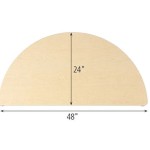How to Seal a Marble Table
Marble is a beautiful and elegant natural stone that adds a touch of sophistication to any home. However, marble is also porous and susceptible to stains, scratches, and etching. Sealing your marble table is essential to protect it from damage and preserve its beauty. This article will walk you through the process of sealing a marble table effectively.
1. Preparing the Marble Table
Before applying sealant, it is crucial to prepare the marble table meticulously. Begin by thoroughly cleaning the surface with a mild stone cleaner. Avoid using harsh chemicals or abrasive cleaning agents as they can damage the marble. After cleaning, dry the table completely with a soft cloth. Ensure all dust particles and debris are removed for optimal sealant adhesion.
Next, inspect the surface for any cracks or chips. If any are present, they should be repaired before sealing. Consult a professional stone restorer for guidance if necessary. Once the table is clean and free of imperfections, it is ready for the sealing process.
2. Choosing the Right Sealant
The type of sealant you choose depends on the intended use of the table and your desired level of protection. There are several types of sealants available, each with advantages and disadvantages:
Penetrating sealants: These sealants soak into the pores of the marble, providing a durable protective barrier. They are ideal for high-traffic areas and surfaces exposed to spills or stains. However, they can impart a slightly sheen to the marble's surface.
Topical sealants: These sealants form a protective layer on the surface of the marble. They offer a higher level of protection against stains and scratches but are less durable than penetrating sealants. Topical sealants are available in various finishes, including matte, gloss, and satin.
Epoxy sealants: These sealants are highly durable and provide a robust barrier against stains and scratches. They are often used for commercial applications or high-wear surfaces. However, epoxy sealants require professional application and can be difficult to remove.
Consult with a stone specialist or review product labels for guidance on choosing the appropriate sealant for your marble table.
3. Applying the Sealant
Once you have selected the desired sealant, follow these steps for application:
1.
Apply a thin, even coat of sealant to the marble surface using a soft cloth or applicator pad.
Avoid applying too much sealant as it may create streaks or leave behind a hazy residue.2.
Work the sealant into the marble in a circular motion.
Allow the sealant to penetrate the pores for the recommended time specified by the manufacturer.3.
Remove any excess sealant with a clean, dry cloth.
Ensure the entire surface is evenly coated and free of streaks or residue.4.
Allow the sealant to dry completely.
The drying time will vary depending on the type of sealant used. Refer to the product label for specific instructions.5.
Apply a second coat of sealant if necessary.
Two coats provide a more durable and long-lasting protective barrier.After applying the sealant, avoid using the table for at least 24 hours to allow the sealant to cure completely.
Sealing your marble table is a straightforward process that can significantly prolong its lifespan and protect it from damage. By following these steps meticulously, you can ensure your marble table maintains its beauty and elegance for years to come.

How To Seal A Marble Table The Right Way Diy Playbook Dining Room

How To Seal A Marble Table The Right Way Diy Playbook

How To Seal A Marble Table The Right Way Diy Playbook

How To Seal A Marble Table The Right Way Diy Playbook

How To Seal A Marble Table The Right Way Diy Playbook

How To Seal A Marble Table The Right Way Diy Playbook

How To Seal A Marble Table The Right Way Diy Playbook

How To Clean A Marble Table Pro Housekeepers

How To Seal A Marble Table The Right Way Diy Playbook Dining Room

How To Treat Seal Granite And Marble Countertops Lesher








